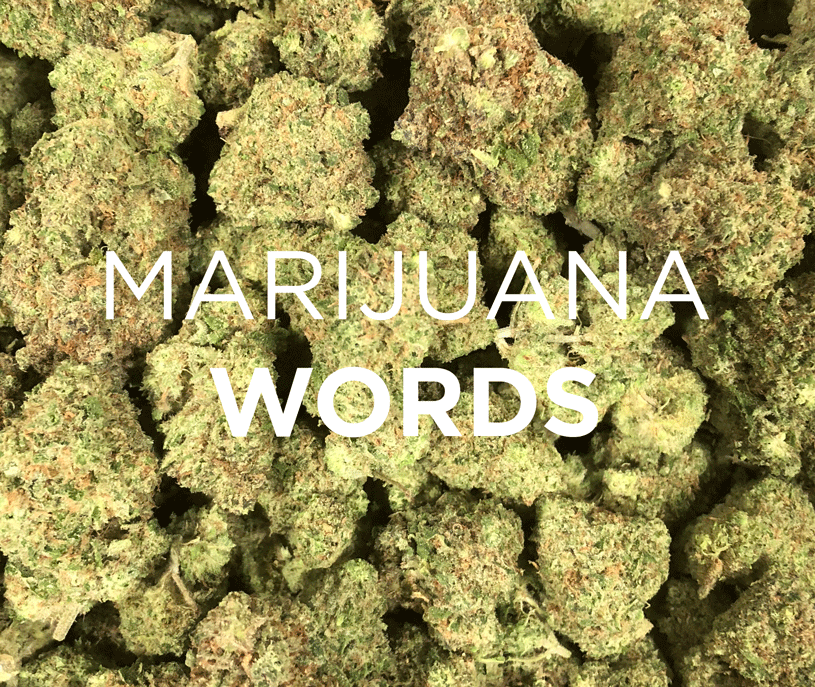
Marijuana Dispensary Words
Saturday, October 20th, 2018
Did you know that “sinsemilla” simply refers to a feminized cannabis plant, and that every strain of flower sold in modern-day dispensaries is in fact sinsemilla? I only ask because someone from the Baby Boomer generation comes in at least once a week and asks, “do you have any sinsemilla?” because that’s what good pot used to be called, and I wanted to set the record straight this week.
It’s the same story with “Thai stick,” which simply refers to old-school cannabis from Thailand wherein pot was wrapped tightly in a “stick” so it could be smuggled into the States. Most Baby Boomers think of Thai stick as the pinnacle of pot, and they all claim to have smoked it, when really, not many people have. And there’s nothing special about it in the first place: most of the cannabis that was smuggled in a few decades ago topped out at 10% THC, and we’ve got some Pineapple Trainwreck on our menu as I write this that’s pushing 30% THC, which blows anything old-school out of the water.
And now that I think about it, I shouldn’t stop with sinsemilla or Thai stick because there’s a litany of esoteric terms used in the cannabis industry, and if you don’t know them, it might sound like your budtender is speaking a foreign language during his or her spiel. And vice-versa, if you’re a Baby Boomer and you use words from your generation in a dispensary, there’s a damn good chance the twenty-five-years-old budtender you meet won’t have a clue what you’re talking about. So, this week, I’m going to talk about all the weird words we use to talk about pot, both now and way-back-when, so we can all be on the same page.
Let’s start with the word “marijuana” itself. A lot of people don’t like that word because it has racist roots (the word was used intentionally way back when to tie cannabis to Mexican drug runners rhetorically to smear cannabis), but it is what it is. And most people think that “marijuana” is a Spanish word, but it’s not: its root can be found in the Spanish word for oregano (“mejorana”) and the English word for oregano (“marjoram”), but nobody’s really sure where the word comes from (if you don’t believe me, ask Wikipedia HERE).
Secondly, there’s a huge difference between hemp and cannabis even though they share a scientific name: hemp cannot get you high, but cannabis is famous for it. Hemp is a tall leafy plant, and the products made from it (textiles and CBD oils) are legal in almost all fifty states; cannabis is a small bushy plant that’s legal only in smart states like Colorado.
Alright… let’s get to some specific words. Do you know the difference between a “joint,” a “pre-roll,” and a “blunt”? Well, the first is something you roll at home, the second is something you buy already rolled from a dispensary, and the third is something rolled with a tobacco wrapper. Of course, tobacco is illegal to sell in a dispensary, so the blunts we sell use a hemp wrapper (they’re awesome).
But if you like loose pot as opposed to joints, you’ve probably heard us refer to it as “flower” instead of “weed” or “pot” because that’s the new fancy term for bud these days. And if you think about it, it’s accurate because the part of the plant you smoke is indeed the “flower.” As to the bud itself, we call it the “cola” officially, but if the buds are small, we call it “popcorn” because the little buds resemble popcorn. And instead of “shake” (which refers to all the trimmed leaves), we call it “trim” because it’s more accurate.
Now, on to descriptive words. As a disclaimer, stoners are notoriously lazy, so most of the words we use to describe cannabis are just abused words. For example, if the flower is leafy instead of dense, we call it “larfy,” which is what it’d sound like if you said “leafy” with a mouthful of peanut butter. And if the flower is grown indoors, we call it “indo,” which is also a term used to describe good cannabis, just like “dank” or “kind.” And if the cannabis is grown hydroponically as opposed to in a soil medium, we call it “hydro” which is also another adjective used to describe good pot (even though the stuff that’s not “hydro” is better). See? We’re learning.
Alright, here come a bunch of words all at once: “OG” stands for “ocean-grown” and most of these strains originated on the Left Coast in California; “kush” refers to a relaxing Indica as does “skunk,” even though the latter strains smell like skunks; “haze” is a moniker that’s usually associated with potent Sativa strains; “diesel” and “chem” are designations associated with strains that smell like fuel or chemicals; words like “mota” or “ganja” or “cheeba” are simply regional names for cannabis. Did you get all that? I hope so. And I’m not going to get into the difference between Indica and Sativa because I’ve harped on that during more than one blog, just like I have when it comes to terpenes or “terps,” which are the compounds that give weed its flavor, smell, and secondary effect. But if you hear someone refer to a specific strain as a “mid” or a “craft mid,” it means that it’s a middle-grade strain that’s just okay.
Boom! Now we all know the same words and we’ll speak the same language when you come into our Durango dispensary. Things like that are important. So please, come see us at 208 Parker Avenue regardless of which words you use, because We’re Your Best Buds, and now we’re on the same page!
